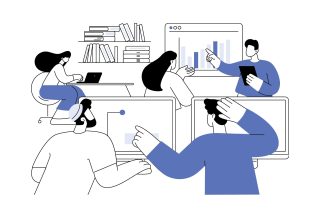FOCUS
ONLINE EXCLUSIVE: Aspiring teachers turn to video
By Meredith A. Riddle
Categories: Career pathways, Fundamentals, Implementation, Learning designs, Online learning, TechnologyDecember 2020
Vol. 41, No. 6
Read the remaining content with membership access. Join or log in below to continue.
Sed ut perspiciatis unde omnis iste natus error sit voluptatem accusantium doloremque laudantium, totam rem aperiam, eaque ipsa quae ab illo inventore veritatis et quasi architecto beatae vitae dicta sunt explicabo. Nemo enim ipsam voluptatem quia voluptas sit aspernatur aut odit aut fugit, sed quia consequuntur magni dolores eos qui ratione voluptatem sequi nesciunt. Neque porro quisquam est, qui dolorem ipsum quia dolor sit amet, consectetur, adipisci velit, sed quia non numquam eius modi tempora incidunt ut labore et dolore magnam aliquam quaerat voluptatem.
10 high-leverage teaching practices
| Practices taught the first six months | Practices taught the last six months |
| 1. Making content (e.g. specific texts, problems, ideas, theories, processes) explicit through explanation, modeling, representations, and examples. | 6. Setting up and managing small-group work.
|
| 2. Leading a whole-class discussion. | 7. Engaging in strategic relationship-building conversations with student. |
| 3. Eliciting and interpreting individual student’s thinking. | 8. Designing a sequence of lessons toward a specific learning goal. |
| 4. Establishing norms and routines for classroom discourse and work that are central to the subject-matter domain. | 9. Providing oral and written feedback to students on their work. |
| 5. Teaching a lesson or segment of instruction. | 10. Communicating with a student’s parent or guardian. |
Source: Shaughnessy & Forzani, 2012.
References
edthena. (n.d.). edthena.com
Gaudin, C. & Chaliès, S. (2016, October 19). Video viewing in teacher education and professional development: A literature review. hal.archives-ouvertes.fr/hal-01384254
Henning, J., Erb, D., Randles, H.S. Shoener, H., Fults, N., & Webb, K. (2016). Designing a curriculum for clinical experiences. Issues in Teacher Education, 25(1), 23-38.
Henning, J.E., Gut, D., & Beam, P. (2015). Designing and implementing a mentoring program to serve a clinically based model of teacher preparation. The Teacher Educator, 150, 145-162.
Jorissen, K.T. (2003). Successful career transitions: Lessons from urban alternate route teachers who stayed. The High School Journal, 86(3), 41-51.
Knight, J. (2014). Focus on teaching: Using video for high-impact instruction. Corwin.
O’Connor, J.R. (2020). Strategic leadership in PK-12 settings: Emerging research and opportunities. IGI Global.
Riddle, M.A. (2019). Developing a curriculum to support the first year of teaching in an alternative-route program [Doctoral dissertation, Monmouth University Department of Education].
Riddle, M., Falco, J., & Henning, J.E. (2017, March). The mentor academy: An innovative approach to teacher preparation. Paper presented at the Professional Development Schools National Conference, Washington, D.C.
Shaughnessy, M. & Forzani, F. (2012). High-leverage teaching practices in teacher education and assessment. TeachingWorks.
Sherin M.G. & Van Es, E.A. (2005). Using video to support teachers’ ability to notice classroom interactions. Journal of Technology and Teacher Education, 13(3), 475-491.
Whitworth, B.A. & Chiu, J.L. (2015). Professional development and teacher change: The missing leadership link. Journal of Science Teacher Education, 26(2), 121-137. doi:10.1007/s10972-014-9411-2
Wright, G.A. (2008). How does video analysis impact teacher reflection-for-action? [Unpublished doctoral dissertation]. Brigham Young University.
Meredith Riddle (mamiller@monmouth.edu) is director of Provisional Teacher Programs, adjunct faculty member at the School of Education, Monmouth University, and a social studies teacher in Long Branch Public Schools.
Categories: Career pathways, Fundamentals, Implementation, Learning designs, Online learning, Technology
Recent Issues
LEARNING DESIGNS
February 2025
Read the remaining content with membership access. Join or log in below to...
BUILDING BRIDGES
December 2024
Read the remaining content with membership access. Join or log in below to...
CURRICULUM-BASED PROFESSIONAL LEARNING
October 2024
Read the remaining content with membership access. Join or log in below to...
LEARNING TO PIVOT
August 2024
Read the remaining content with membership access. Join or log in below to...












